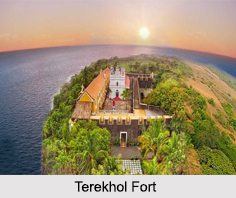 Terekhol Fort is a fort in Goa, but geographically in Maharashtra. It lies right at the border between Maharashtra and Goa. The fort is located on the northern tip of Goa at the mouth of the Tiracol River. Now, in a state of ruins, Terekhol Fort has been converted into a hotel, the Fort Terekhol Heritage. Terekhol Fort has witnessed several interesting episodes of India"s history. This fort is one of the most popular tourist attractions of Goa. It provides magnificent views of the Tiracol River and Arabian Sea.
Terekhol Fort is a fort in Goa, but geographically in Maharashtra. It lies right at the border between Maharashtra and Goa. The fort is located on the northern tip of Goa at the mouth of the Tiracol River. Now, in a state of ruins, Terekhol Fort has been converted into a hotel, the Fort Terekhol Heritage. Terekhol Fort has witnessed several interesting episodes of India"s history. This fort is one of the most popular tourist attractions of Goa. It provides magnificent views of the Tiracol River and Arabian Sea.
Etymology of Terekhol Fort
Terekhol Fort is sometimes known as "Fort Tiracol". The name of the fort "Terekhol" probably originated from the Marathi word "tir-khol" meaning "steep river-bank".
History of Terekhol Fort
Terekhol Fort was originally built by Maharaja Khem Sawant Bhonsle, the Raja of Sawantwadi, in the 17th century. In 1746, the Portuguese under the 44th Viceroy of Goa, Pedro Miguel de Almeida waged war against the Raja of Sawantwadi and captured the fort. It remained in Portuguese control till December 1961. In 1819, following the defeat of the Marathas, a treaty was signed by Raja Bhonsle Khem Sawant of Sawantwadi who recognised British dominion. This treaty effectively abolished the strategic importance of the fort, as it became an enclave in territory controlled by British allies.
During the Portuguese Civil War, the fort served as a rebel stronghold during an uprising in 1825 against the Portuguese led by Dr. Bernardo Peres da Silva, the first Goan born Viceroy of Goa. Fort Terekhol was a symbolic location where freedom fighters from Goa demonstrated from time to time. On 15 August 1954, Satyagrahis protesting Portuguese rule entered Goa from three different directions - one of which was from the North to Fort Terekhol, which was occupied and flew the Indian flag for a day before they were captured and imprisoned.
Structure of Terekhol Fort
Fascinating pieces of architecture on the fort are its turrets, which enhance the beauty of the fort as a whole. The fort initially consisted of 12 guns, a barrack and a chapel. A Church for the Holy Trinity was constructed in the fort courtyard by de Almeida after its capture. This later became the century-old Church of St. Anthony.
Visiting Information of Terekhol Fort
Terekhol Fort is reached by a ferry from Querim, 42 km North of Panaji. One can reach the fort by hiring a taxi or auto, anywhere from North Goa.



















